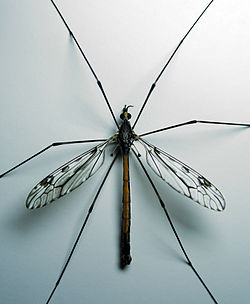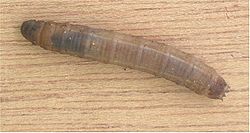Crane fly
| Crane flies | |
|---|---|

| |
| adult | |

| |
| larva (leatherjacket) | |
| Scientific classification | |
| Kingdom: | |
| Phylum: | |
| Class: | |
| Order: | |
| Family: | Tipulidae Latreille, 1802
|
| Genera | |
|
this list may be incomplete
| |
Insects in the family Tipulidae are commonly known as crane flies. Adults are very slender, long-legged flies that may vary in length from 2–60 mm (tropical species may exceed 100 mm).
Numerous other common names have been applied to the crane fly, many of them more or less regional, including, mosquito hawks, mosquito eaters (or skeeter eaters), gallinippers, gollywhoppers, and jimmy spinners. In the United Kingdom they are commonly referred to as daddy long-legs, but this name can also refer to two unrelated arthropods: members of the arachnid order Opiliones (especially in the United States) and the cellar spider Pholcidae (especially in Australia).
At least 14,000 species of crane flies have been described, most of them (75%) by the specialist Charles Paul Alexander. This makes the Tipulidae the largest family of Diptera.
Morphology

In appearance crane flies seem long and gangly, with very long legs, and a long slender abdomen. The wings are often held out when at rest, making the large halteres (balancers) easily visible. Unlike mosquitoes, crane flies are weak and poor fliers with a tendency to "wobble" in unpredictable patterns during flight, and they can be caught without much effort. However, it is very easy to accidentally break off their delicate legs when catching them, even without direct contact. This may help them to evade the birds who pursue them as prey[citation needed]. Crane flies are variable in size, with temperate species ranging from 2 mm up to 60 mm, while tropical species have been recorded at over 100 mm [citation needed]. The Giant Crane Fly (Holorusia rubiginosa) of the western United States can reach 38 mm (1.5 inches). Some Tipula species are 64 mm (2-1/2 inches). There are many smaller species (known as bobbing gnats) that are mosquito-sized, but they can be distinguished from mosquitoes by the V-shaped suture on the thorax and a lack of ocelli[citation needed].
The females have swollen abdomens in comparison to the males because they contain eggs. The female abdomen also ends in a pointed ovipositor that looks a bit like a stinger but is completely harmless.
Adult mouthparts may occur on the end of the crane fly's long face, which is sometimes called a snout or a short rostrum.
Larvae have a distinct head capsule, and their abdominal segments often have long fleshy projections (almost like tentacles).
Ecology
Despite their common names, crane flies do not prey on mosquitoes as adults, nor do they bite humans. Some larval crane flies may on occasion feed on mosquito larvae.[1] Adult crane flies feed on nectar or they do not feed at all; most crane fly species live only to mate and die once they become adults. Their larvae, called "leatherjackets" or "leatherjacket slugs" because of the way they move, consume roots (such as those of turf grass in backyard lawns) and other vegetation, in some cases causing damage to plants. Therefore the crane fly is occasionally considered a mild turf pest in some areas.
Of the juvenile biology of many crane fly species little is known. The larvae of less than 2% of the species have been described. Of those that have been described, many prefer moist environments, and some leatherjackets are aquatic.
The long legs are an adaptation to allow the fly to alight in grassy places.
Crane flies serve as a food source for many birds.
Species lists
- Australasian / Oceanian includes family account by Pjotr Oosterbroek
See also
- Crane fly orchid (Tipularia discolor)
External links
- Family descriptions and images
- Ohio State University Fact Sheet
- Crane Flies of Pennsylvania Extensive Specimen Collection, Carnegie Museum of Natural History
- Crane Fly Tipula (Platytipula) paterifera Diagnostic closeup photos and information
- Crane Fly Tipula dorsimacula Reference photographs of female ovipositing
- Catalog of Craneflies of the World
- Family Tipulidae
- Image Gallery from Diptera.info
- Image Gallery from Bug Guide Extensive photo gallery, many species
- Japanese Tipulidae In Traditional Chinese but images are under Latin binomials]
- Grass damage Damage caused to grass by Crane Fly larvae
References
- Oosterbroek, Pjotr. "Tipulidae" http://hbs.bishopmuseum.org/aocat/tipulidae.html
